Formation and Surface Structures of Long-Range Ordered Self-Assembled Monolayers of 2-Mercaptopyrazine on Au(111)
Abstract
1. Introduction
2. Results and Discussion
2.1. The Formation and Surface Structures of 2-PyzS SAMs on Au(111) at pH 2
2.2. The Formation and Surface Structures of 2-PyzS SAMs on Au(111) at pH 8
2.3. S 2p XPS Peaks for 2-PyZS SAMs on Au(111) at Different Solution pH
2.4. N 1s XPS Peaks for 2-PyZS SAMs on Au(111) at Different Solution pH
3. Materials and Methods
3.1. Chemicals and Fabrication of Au(111) Substrates
3.2. Preparation of 2-PyzS SAMs
3.3. STM and XPS Measurements
4. Conclusions
Author Contributions
Funding
Institutional Review Board Statement
Informed Consent Statement
Data Availability Statement
Conflicts of Interest
References
- Love, J.C.; Estroff, L.A.; Kriebel, J.K.; Nuzzo, R.G.; Whitesides, G.M. Self-Assembled Monolayers of Thiolates on Metals as a Form of Nanotechnology. Chem. Rev. 2005, 105, 1103–1170. [Google Scholar] [CrossRef] [PubMed]
- Vericat, C.; Vela, M.E.; Benitez, G.; Carro, P.; Salvarezza, R.C. Self-Assembled Monolayers of Thiols and Dithiols on Gold: New Challenges for a Well-known System. Chem. Soc. Rev. 2010, 39, 1805–1834. [Google Scholar] [CrossRef]
- Cyganik, P.; Terfort, A.; Zharnikov, M. Odd-even Effects in the Structure and Properties of Aryl-substituted Aliphatic Self-Assembled Monolayers. Nano Res. 2024, 17, 4231–4243. [Google Scholar] [CrossRef]
- Han, S.; Seong, S.; Son, Y.J.; Yokota, Y.; Hayashi, T.; Hara, M.; Noh, J. Formation and Surface Structures of Highly Ordered Self-Assembled Monolayers of Alkyl Selenocyanates on Au (111) Via Ambient-Pressure Vapor Deposition. J. Phys. Chem. C 2020, 124, 26730–26740. [Google Scholar] [CrossRef]
- Muneyasu, R.; Yamada, T.; Akai-Kasaya, M.; Kato, H.S. Self-Assembly of Heterogeneous Bilayers Stratified by Au–S and Hydrogen Bonds on Au (111). Phys. Chem. Chem. Phys. 2022, 24, 22222–22230. [Google Scholar] [CrossRef]
- Wu, H.; Li, G.; Hou, J.; Sotthewes, K. Probing Surface Properties of Organic Molecular Layers by Scanning Tunneling Microscopy. Adv. Colloid Interface Sci. 2023, 318, 102956. [Google Scholar] [CrossRef]
- Seong, S.; Kang, H.; Kim, H.; Son, Y.J.; Jang, J.; Maeda, S.; Chikami, S.; Hayashi, T.; Yoon, H.J.; Noh, J. Effects of the Substituent Position on the Structural Order, Work Function Change, and Thermopower of Dichloro-Substituted Benzenethiolate Self-Assembled Monolayers on Au (1 1 1). Appl. Surf. Sci. 2024, 643, 158661. [Google Scholar] [CrossRef]
- Liu, Y.; Tao, X.; Wang, Y.; Jiang, C.; Ma, C.; Sheng, O.; Lu, G.; Lou, X.W. Self-Assembled Monolayers Direct a Lif-Rich Interphase toward Long-Life Lithium Metal Batteries. Science 2022, 375, 739–745. [Google Scholar] [CrossRef]
- Son, Y.J.; Han, J.W.; Kang, H.; Seong, S.; Han, S.; Maeda, S.; Chikami, S.; Hayashi, T.; Hara, M.; Noh, J. Formation and Thermal Stability of Ordered Self-Assembled Monolayers by the Adsorption of Amide-Containing Alkanethiols on Au(111). Int. J. Mol. Sci. 2023, 24, 3241. [Google Scholar] [CrossRef]
- Azzam, W.; Subaihi, S.; Al-Rawashdeh, N.A.F.; Al-Nawaiseh, A. Imaging of Terphenyldithiol Molecules in Highly Orientated and Ordered Aromatic Dithiol SAMs on Au(111). J. Phys. Chem. C 2024, 128, 4093–4103. [Google Scholar] [CrossRef]
- Lee, J.H.; Han, J.W.; Lee, G.; Han, S.; Kim, H.; Seo, D.; Kaizu, R.; Latag, G.V.; Hayashi, T.; Noh, J. Effect of Anchoring Groups on the Formation of Self-Assembled Monolayers on Au(111) from Cyclohexanethiol and Cyclohexyl Thiocyanate. Thin Solid Film. 2024, 808, 140560. [Google Scholar] [CrossRef]
- Liu, Y.; Notz, S.; Lang, H.; Zharnikov, M. Pyrene-Terminated Self-Assembled Monolayers on Au Substrate: Molecular Organization and Charge Transport Properties. J. Phys. Chem. C 2023, 127, 19290–19300. [Google Scholar] [CrossRef]
- Lee, N.-S.; Kim, D.; Kang, H.; Park, D.K.; Han, S.W.; Noh, J. Structural Transitions of Octanethiol Self-Assembled Monolayers on Gold Nanoplates after Mild Thermal Annealing. J. Phys. Chem. C 2011, 115, 5868–5874. [Google Scholar] [CrossRef]
- Raymundo-Pereira, P.A.; de Oliveira Pedro, R.; Carr, O.; Melendez, M.E.; Gobbi, A.L.; de Oliveira Piazzetta, M.H.; Carvalho, A.L.; Reis, R.M.; Miranda, P.B.; Oliveira, O.N., Jr. Influence of the Molecular Orientation and Ionization of SelfAssembled Monolayers in Biosensors: Application to Genosensors of Prostate Cancer Antigen 3. J. Phys. Chem. C 2021, 125, 498–506. [Google Scholar] [CrossRef]
- Kim, K.J.; Song, Y.; Park, S.; Oh, S.J.; Kwon, S.J. Immunosensor for Human Ige Detection Using Electrochemical Redox Cycling with Ferrocene-Mixed Self-Assembled Monolayers Modified Au Electrode. Bull. Korean Chem. Soc. 2023, 44, 141–146. [Google Scholar] [CrossRef]
- Dai, Z.; Yadavalli, S.K.; Chen, M.; Abbaspourtamijani, A.; Qi, Y.; Padture, N.P. Interfacial Toughening with Self-Assembled Monolayers Enhances Perovskite Solar Cell Reliability. Science 2021, 372, 618–622. [Google Scholar] [CrossRef]
- Kim, S.Y.; Cho, S.J.; Byeon, S.E.; He, X.; Yoon, H.J. Self-Assembled Monolayers as Interface Engineering Nanomaterials in Perovskite Solar Cells. Adv. Energy Mater. 2020, 10, 2002606. [Google Scholar] [CrossRef]
- Lee, B.; Takeda, S.; Nakajima, K.; Noh, J.; Choi, J.; Hara, M.; Nagamune, T. Rectified Photocurrent in a Protein Based Molecular Photo-Diode Consisting of a Cytochrome B562-Green Fluorescent Protein Chimera Self-Assembled Monolayer. Biosens. Bioelectron. 2004, 19, 1169–1174. [Google Scholar] [CrossRef]
- Casalini, S.; Bortolotti, C.A.; Leonardi, F.; Biscarini, F. Self-Assembled Monolayers in Organic Electronics. Chem. Soc. Rev. 2017, 46, 40–71. [Google Scholar] [CrossRef]
- Tsvetanova, M.; Oldenkotte, V.J.S.; Bertolino, M.C.; Gao, Y.; Siekman, M.H.; Huskens, J.; Zandvliet, H.J.W.; Sottewes, K. Nanoscale Work Function Contrast Induced by Decanethiol Self-Assembled Monolayers on Au(111). Langmuir 2020, 36, 12745–12754. [Google Scholar] [CrossRef]
- Jang, J.; He, P.; Yoon, H.J. Molecular Thermoelectricity in Egain-Based Molecular Junctions. Acc. Chem. Res. 2023, 56, 1613–1622. [Google Scholar] [CrossRef] [PubMed]
- Heimel, G.; Rissner, F.; Zojer, E. Modeling the Electronic Properties of π-Conjugated Self-Assembled Monolayers. Adv. Mater. 2010, 22, 2494–2513. [Google Scholar] [CrossRef] [PubMed]
- Kang, H.; Seong, S.; Ito, E.; Isoshima, T.; Hara, M.; Yoon, H.J.; Noh, J. Comparative Study of Structural Order, Thermal Desorption Behavior, and Work Function Change of Self-Assembled Monolayers of Pentafluorobenzenethiols and Tetrafluorobenzenethiols on Au(111). Appl. Surf. Sci. 2021, 555, 149671. [Google Scholar] [CrossRef]
- Wang, L.; Liu, L.; Chen, W.; Feng, Y.; Wee, A.T. Configuration-Dependent Interface Charge Transfer at a Molecule−Metal Junction. J. Am. Chem. Soc. 2006, 128, 8003–8007. [Google Scholar] [CrossRef] [PubMed]
- Thuo, M.M.; Reus, W.F.; Nijhuis, C.A.; Barber, J.R.; Kim, C.; Schulz, M.D.; Whitesides, G.M. Odd−Even Effects in Charge Transport across Self-Assembled Monolayers. J. Am. Chem. Soc. 2011, 133, 2962–2975. [Google Scholar] [CrossRef]
- Seo, K.; Lee, H. Molecular Electron Transport Changes Upon Structural Phase Transitions in Alkanethiol Molecular Junctions. ACS Nano 2009, 3, 2469–2476. [Google Scholar] [CrossRef]
- Armstrong, F.A.; Hill, H.A.O.; Walton, N.J. Direct Electrochemistry of Redox Proteins. Acc. Chem. Res. 1988, 21, 407–413. [Google Scholar] [CrossRef]
- Frew, J.E.; Hill, H.A.O. Direct and Indirect Electron Transfer between Electrodes and Redox Proteins. Eur. J. Biochem. 1988, 172, 261–269. [Google Scholar] [CrossRef]
- Yoshimoto, S. Molecular Assemblies of Functional Molecules on Gold Electrode Surfaces Studied by Electrochemical Scanning Tunneling Microscopy: Relationship between Function and Adlayer Structures. Bull. Chem. Soc. Jpn. 2006, 79, 1167–1190. [Google Scholar] [CrossRef]
- Monari, S.; Ranieri, A.; Bortolotti, C.A.; Peressini, S.; Tavagnacco, C.; Borsari, M. Unfolding of Cytochrome C Immobilized on Self-Assembled Monolayers. An Electrochemical Study. Electrochim. Acta 2011, 56, 6925–6931. [Google Scholar] [CrossRef]
- Allen, P.M.; Allen, H.; Hill, O.; Walton, N.J. Surface Modifiers for the Promotion of Direct Electrochemistry of Cytochrome C. J. Electroanal. Chem. Interf. Electrochem. 1984, 178, 69–86. [Google Scholar] [CrossRef]
- Lindell, L.; Vahlberg, C.; Uvdal, K.; Fahlman, M.; Braun, S. Self-Assembled Monolayer Engineered Interfaces: Energy Level Alignment Tuning through Chain Length and End-Group Polarity. J. Electron. Spectrosc. Relat. Phenom. 2015, 204, 140–144. [Google Scholar] [CrossRef]
- Gärtner, M.; Sauter, E.; Nascimbeni, G.; Petritz, A.; Wiesner, A.; Kind, M.; Abu-Husein, T.; Bolte, M.; Stadlober, B.; Zojer, E. Understanding the Properties of Tailor-Made Self-Assembled Monolayers with Embedded Dipole Moments for Interface Engineering. J. Phys. Chem. C 2018, 122, 28757–28774. [Google Scholar] [CrossRef]
- Petritz, A.; Krammer, M.; Sauter, E.; Gärtner, M.; Nascimbeni, G.; Schrode, B.; Fian, A.; Gold, H.; Cojocaru, A.; Karner-Petritz, E. Embedded Dipole Self-Assembled Monolayers for Contact Resistance Tuning in P-Type and N-Type Organic Thin Film Transistors and Flexible Electronic Circuits. Adv. Funct. Mater. 2018, 28, 1804462. [Google Scholar] [CrossRef]
- Gärtner, M.; Sauter, E.; Nascimbeni, G.; Wiesner, A.; Kind, M.; Werner, P.; Schuch, C.; Abu-Husein, T.; Asyuda, A.; Bats, J.W. Self-Assembled Monolayers with Distributed Dipole Moments Originating from Bipyrimidine Units. J. Phys. Chem. C 2019, 124, 504–519. [Google Scholar] [CrossRef]
- Matković, A.; Petritz, A.; Schider, G.; Krammer, M.; Kratzer, M.; Karner-Petritz, E.; Fian, A.; Gold, H.; Gärtner, M.; Terfort, A. Interfacial Band Engineering of MoS2/Gold Interfaces Using Pyrimidine-Containing Self-Assembled Monolayers: Toward Contact-Resistance-Free Bottom-Contacts. Adv. Electron. Mater. 2020, 6, 2000110. [Google Scholar] [CrossRef]
- Berdiyorov, G.R.; Hamoudi, H. Electronic Transport through Molecules Containing Pyrimidine Units: First-Principles Calculations. J. Comput. Sci. 2021, 48, 101261. [Google Scholar] [CrossRef]
- Manolova, M.; Ivanova, V.; Kolb, D.M.; Boyen, H.G.; Ziemann, P.; Büttner, M.; Romanyuk, A.; Oelhafen, P. Metal Deposition onto Thiol-Covered Gold:: Platinum on a 4-Mercaptopyridine SAM. Surf. Sci. 2005, 590, 146–153. [Google Scholar] [CrossRef]
- Eberle, F.; Saitner, M.; Boyen, H.-G.; Kucera, J.; Gross, A.; Romanyuk, A.; Oelhafen, P.; D’Olieslaeger, M.; Manolova, M.; Kolb, D.M. A Molecular Double Decker: Extending the Limits of Current Metal-Molecule Hybrid Structures. Angew. Chem. Int. Ed. 2010, 49, 341–345. [Google Scholar] [CrossRef]
- Müller, H.; Metzler, M.; Barth, N.; Conings, B.; Boyen, H.-G.; Jacob, T.; Kibler, L.A. Electrocatalytic Behavior of Pd and Pt Nanoislands Deposited onto 4, 4′-Dithiodipyridine Sams on Au (111). Electrocatalysis 2018, 9, 505–513. [Google Scholar] [CrossRef]
- Hermann, J.M.; Müller, H.; Daccache, L.; Adler, C.; Keller, S.; Metzler, M.; Jacob, T.; Kibler, L.A. Formic Acid Oxidation Reaction on Au(111) Electrodes Modified with 4-Mercaptopyridine SAM. Electrochim. Acta 2021, 388, 138547. [Google Scholar] [CrossRef]
- Piescheck, M.; Abdelrahman, A.; Hermann, J.M.; Müller, H.; Jacob, T.; Kibler, L.A. Hydrogen Peroxide Oxidation Reaction on a 4-Mercaptopyridine Self-Assembled Monolayer on Au (111) Metallized by Platinum Nanoislands. Electrocatalysis 2021, 12, 264–271. [Google Scholar] [CrossRef]
- Sawaguchi, T.; Mizutani, F.; Yoshimoto, S.; Taniguchi, I. Voltammetric and in Situ STM Studies on Self-Assembled Monolayers of 4-Mercaptopyridine, 2-Mercaptopyridine and Thiophenol on Au(111) Electrodes. Electrochim. Acta 2000, 45, 2861–2867. [Google Scholar] [CrossRef]
- Seo, D.; Seong, S.; Kim, H.; Oh, H.S.; Lee, J.H.; Kim, H.; Kim, Y.O.; Maeda, S.; Chikami, S.; Hayashi, T.; et al. Molecular Self-Assembly and Adsorption Structure of 2, 2′-Dipyrimidyl Disulfides on Au (111) Surfaces. Molecules 2024, 29, 846. [Google Scholar] [CrossRef]
- Davis, J.J.; Hill, H.A.O.; Yamada, R.; Naohara, H.; Uosaki, K. Scanning Tunnelling Microscopy Study of the Self Assembly of 2-Mercaptopyrimidine and 4,6-Dimethyl-2-mercaptopyrimidine on Au(111). J. Chem. Soc. Faraday Trans. 1998, 94, 1315–1319. [Google Scholar] [CrossRef]
- Nishiyama, K.; Tsuchiyama, M.; Kubo, A.; Seriu, H.; Miyazaki, S.; Yoshimoto, S.; Taniguchi, I. Conformational Change in 4-Pyridineethanethiolate Self-assembled Monolayers on Au(111) Driven by Protonation/deprotonation in Electrolyte Solutions. Phys. Chem. Chem. Phys. 2008, 10, 6935–6939. [Google Scholar] [CrossRef]
- Pang, Y.S.; Hwang, H.J.; Kim, M.S. Adsorption of 2-Mercaptopyridine and 2-Mercaptopyrimidine on a Silver Colloidal Surface Investigated by Raman Spectroscopy. J. Mol. Struct. 1998, 441, 63–76. [Google Scholar] [CrossRef]
- Wattanavichean, N.; Casey, E.; Nochols, R.J.; Arnolds, H. Discrimination between Hydrogen Bonding and Protonation in the Spectra of a Surface-enhanced Raman Sensor. Phys. Chem. Chem. Phys. 2018, 20, 866–871. [Google Scholar] [CrossRef]
- Hu, J.; Zhao, B.; Xu, W.; Li, B.; Fan, Y. Surface-enhanced Raman Spectroscopy Study on the Structure Changes of 4-Mecaptopyridine Adsorbed on Silver Substrates and Silver Colloids. Spectrochim. Acta 2002, 58, 2827–2834. [Google Scholar] [CrossRef]
- Wan, L.-J.; Noda, H.; Hara, Y.; Osawa, M. Effect of Solution pH on the Structure of a 4-Mercaptopyridine Monolayers Self-Assembled on Au(111). J. Electroanal. Chem. 2000, 489, 68–75. [Google Scholar] [CrossRef]
- Taniguchi, I.; Ishimoto, H.; Miyagawa, K.; Iwai, M.; Nagai, H.; Hanazono, H.; Taira, K.; Kubo, A.; Nishikawa, A.; Nishiyama, K. Surface Functions of 2-Mercaptopyridine, 2-Mercaptopyrazine and 2-Mercaptoquinoxaline Modified Au (111) Electrodes for Direct Rapid Electron Transfer of Cytochrome C. Electrochem. Commun. 2003, 5, 857–861. [Google Scholar] [CrossRef]
- Yang, G.; Liu, G.Y. New Insights for Self-Assembled Monolayers of Organothiols on Au(111) Revealed by Scanning Tunneling Microscopy. J. Phys. Chem. B 2003, 107, 8746–8759. [Google Scholar] [CrossRef]
- Kang, H.; Park, T.; Choi, I.; Lee, Y.; Ito, E.; Hara, M.; Noh, J. Formation of Large Ordered Domains in Benzenethiol Self-assembled Monolayers on Au(111) Observed by Scanning Tunneling Microscopy. Ultramicroscopy 2009, 109, 1011–1014. [Google Scholar] [CrossRef] [PubMed]
- Azzam, W.; Bashir, A.; Ulrich Biedermann, P.; Rohwerder, M. Formation of Highly Ordered and Orientated Gold Islands: Effect of Immersion Time on the Molecular Adlayer Structure of Pentafluorobenzenethiols (PFBT) SAMs on Au(111). Langmuir 2012, 28, 10192–10208. [Google Scholar] [CrossRef]
- Choi, Y.; Seong, S.; Son, Y.G.; Han, S.; Ito, E.; Mondarte, E.A.Q.; Chang, R.; Hayashi, T.; Hara, M.; Noh, J. Formation of Long-Range-Ordered Self-Assembled Monolayers of Dodecyl Thiocyanates on Au(111) via Ambient-Pressure Vapor Deposition. Colloid Surf. A Physicochem. Eng. Asp. 2019, 583, 123969. [Google Scholar] [CrossRef]
- Asyuda, A.; Das, S.; Zharnikov, M. Thermal Stability of Alkanethiolate and Aromatic Thiolate Self-Assembled Monolayers on Au(111): An X-Ray Photoelectron Spectroscopy Study. J. Phys. Chem. C 2021, 125, 21754–21763. [Google Scholar] [CrossRef]
- Ishida, T.; Hara, M.; Kojima, I.; Tsuneda, S.; Nishida, N.; Sasabe, H.; Knoll, W. High-Resolution X-Ray Photoelectron Spectroscopy Measurements of Octadecanethiol Self-Assembled Monolayers on Au(111). Langmuir 1998, 14, 2092–2096. [Google Scholar] [CrossRef]
- Castner, D.G.; Hinds, K.; Grainger, D.W. X-Ray Photoelectron Spectroscopy Sulfur 2p Study of Organic Thiol and Disulfide Binding Interactions with Gold Surfaces. Langmuir 1996, 12, 5083–5086. [Google Scholar] [CrossRef]
- Zhang, H.L.; Evans, S.D.; Henderson, J.R.; Miles, R.E.; Shen, T. Spectroscopic Characterization of Gold Nanoparticles Passivated by Mercaptopyridine and Mercaptopyrimidine Derivatives. J. Phys. Chem. B 2003, 107, 6087–6095. [Google Scholar] [CrossRef]
- Herrera, S.H.; Tasca, F.; Williams, F.J.; Calvo, E.J. Surface Structure of 4-Mercaptopyridine on Au(111): A New Dense Phase. Langmuir 2017, 33, 9565–9572. [Google Scholar] [CrossRef]
- Saha, S.; Dutta, B.; Ghosh, M.; Chowdhury, J. Adsorption of 4-Mercaptopyridine with Gold Nanoparticles Embedded in the Langmuir-Blodgett film matrix of stearic acid: SERS, XPS Studies Aided by Born-Oppenheimer on the Fly Dynamics, Time-Resolved Wavelet Transform Theory, DFT. ACS Omega 2022, 7, 27818–27830. [Google Scholar] [CrossRef]


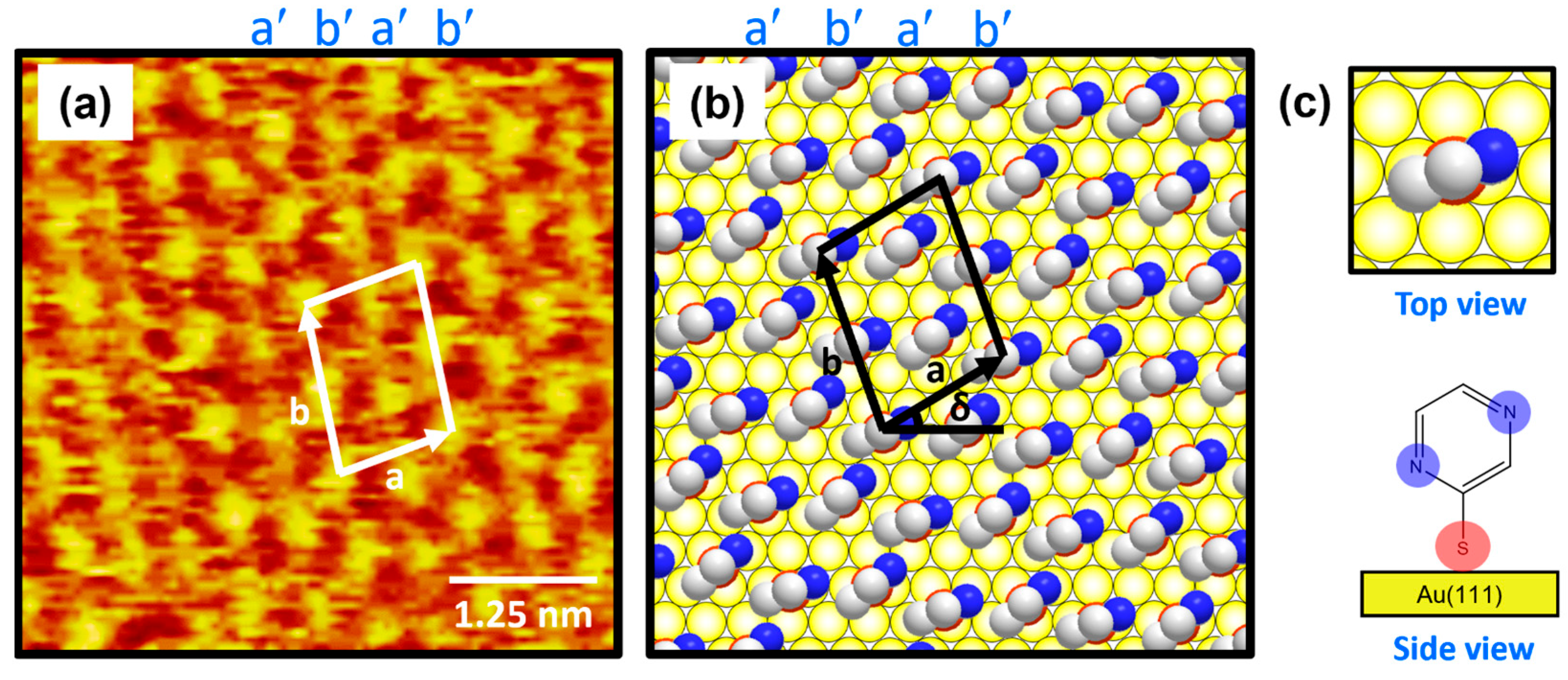
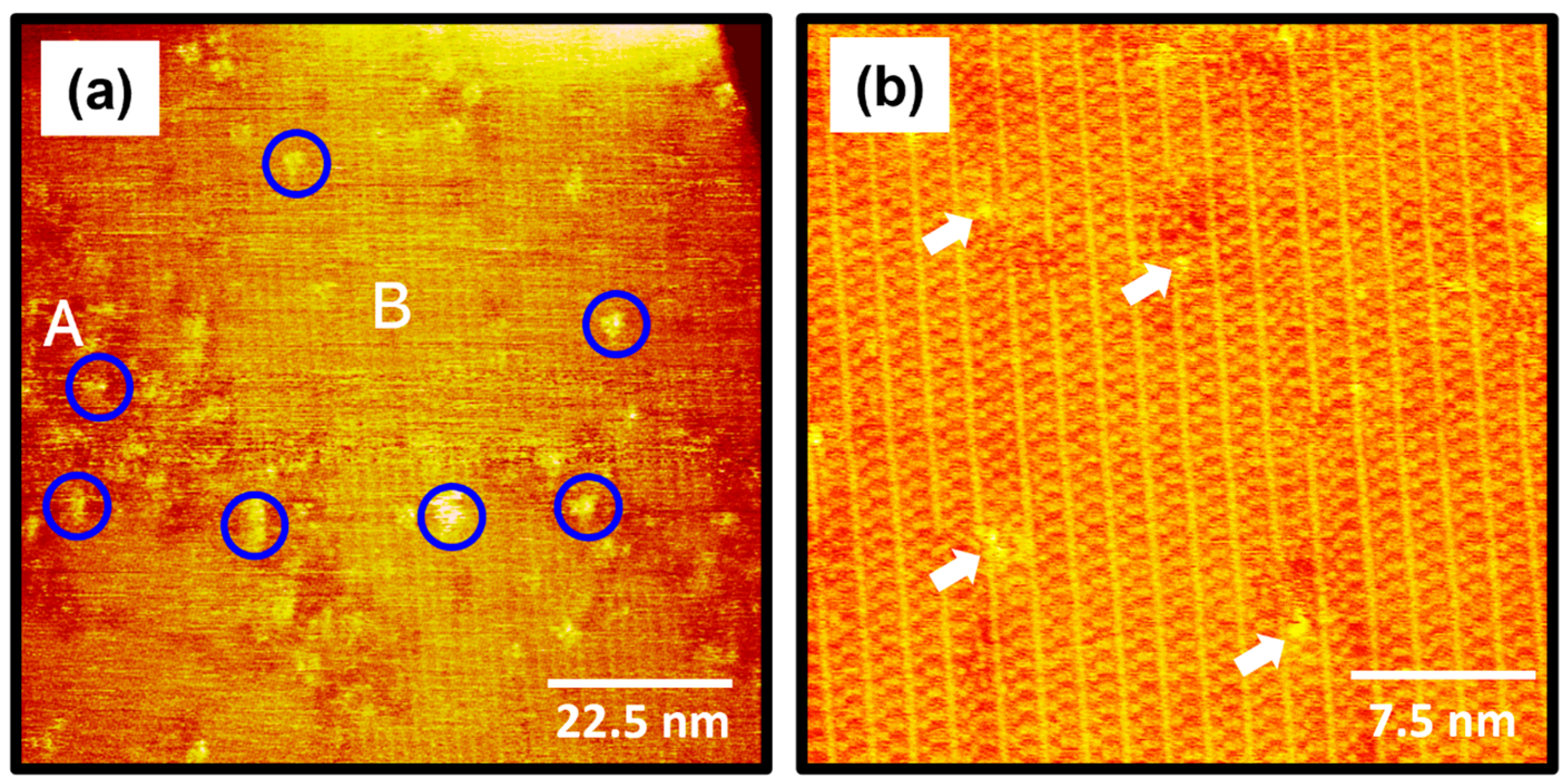
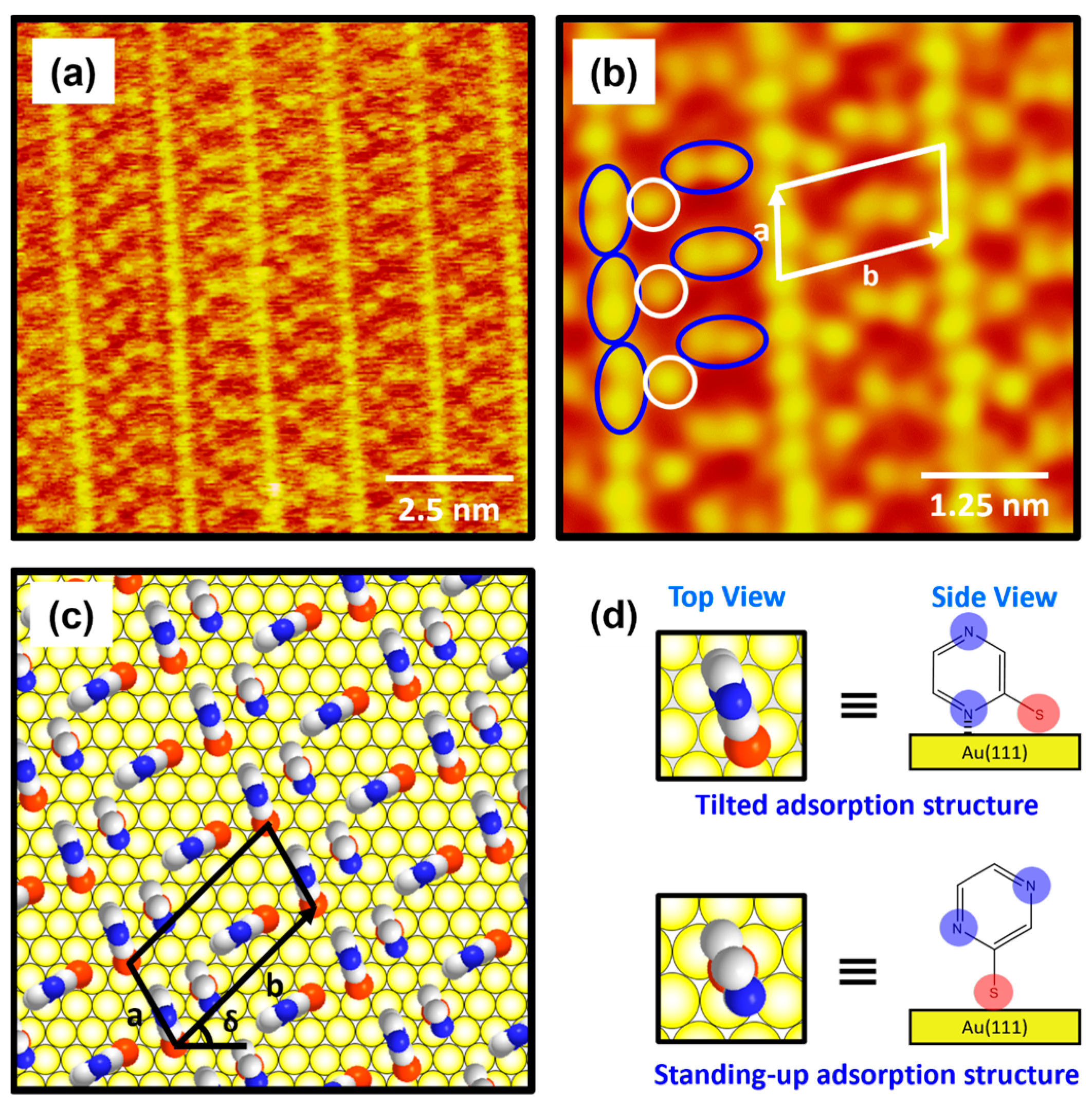
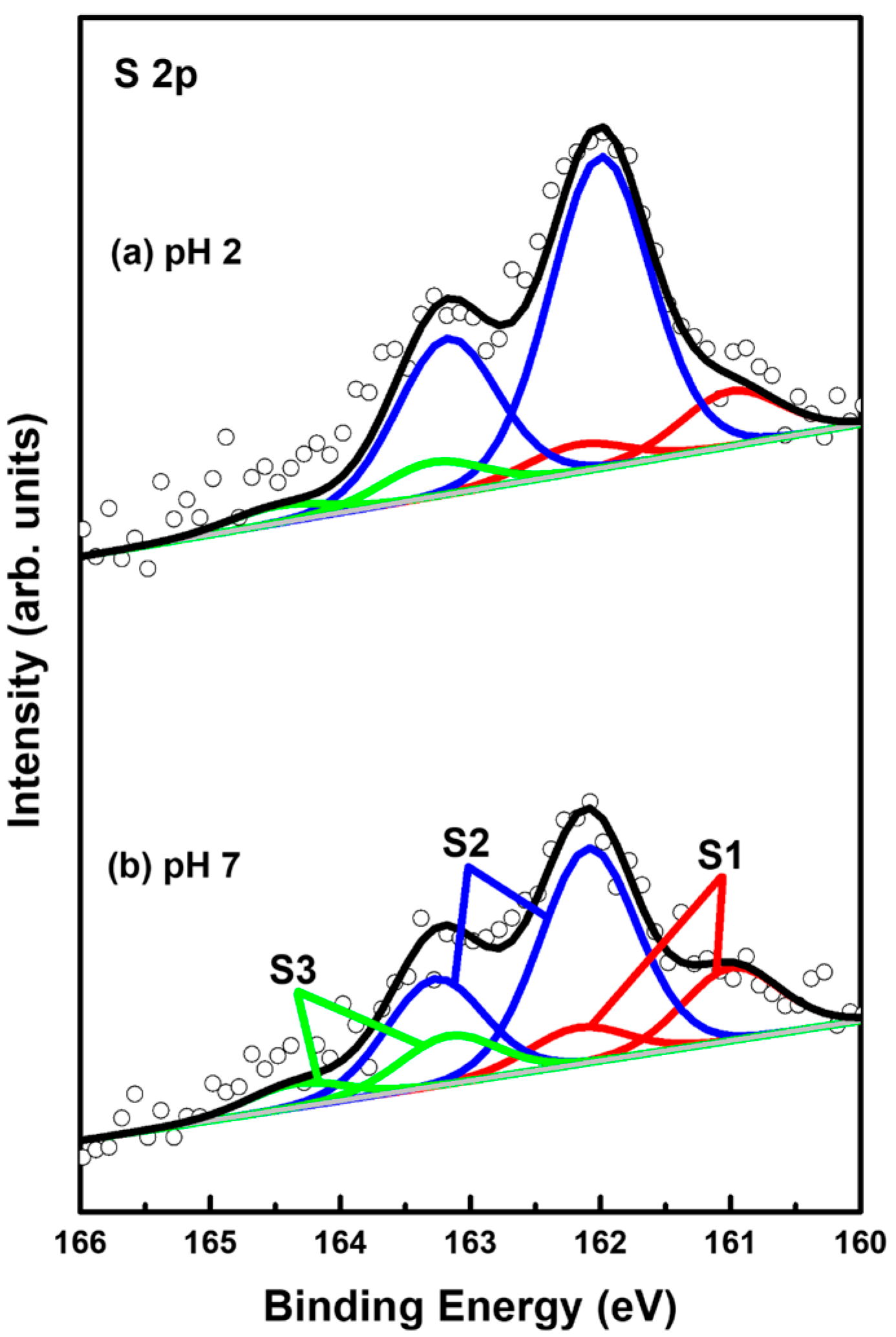
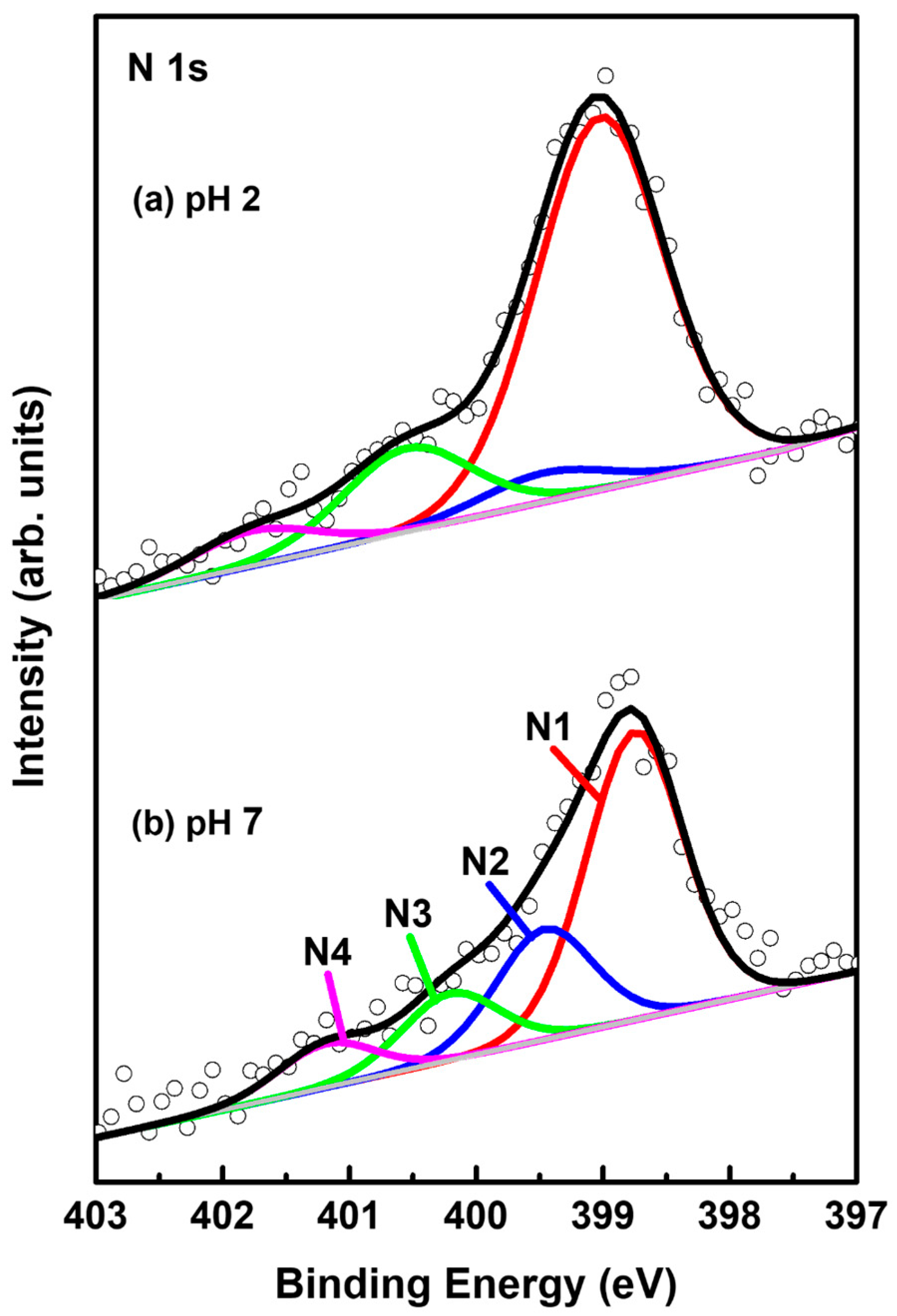
| SAM Sample | pH Condition | Packing Structure | Arial Molecular Density |
|---|---|---|---|
| 2-PyzS SAMs | 2 | (2√3 × √21)R30° | 32.55 Å2/molecule |
| 2-PyzS SAMs | 8 | (3 × √37)R43° | 49.47 Å2/molecule |
| pH Condition | S 2p Species | Peak (eV) a | S 2p/Au 4f b | S1 + S2/Au 4f b |
|---|---|---|---|---|
| pH = 2 | S1 | 161.05 | 0.00027 | 0.00182 |
| S2 | 162.06 | 0.00152 | ||
| S3 | 163.30 | 0.00017 | ||
| pH = 7 | S1 | 161.11 | 0.00041 | 0.00129 |
| S2 | 162.13 | 0.00088 | ||
| S3 | 163.17 | 0.00021 |
| pH Condition | N 1s Species | Peak (eV) | N 1s/Au 4f a | N1/N2 |
|---|---|---|---|---|
| pH = 2.0 | N1 | 398.98 | 0.00324 | 12.96 |
| N2 | 399.52 | 0.00025 | ||
| N3 | 400.55 | 000073 | ||
| N4 | 401.77 | 0.00030 | ||
| pH = 8 | N1 | 398.95 | 0.00175 | 2.61 |
| N2 | 399.66 | 0.00067 | ||
| N3 | 400.41 | 0.00041 | ||
| N4 | 401.38 | 0.00027 |
Disclaimer/Publisher’s Note: The statements, opinions and data contained in all publications are solely those of the individual author(s) and contributor(s) and not of MDPI and/or the editor(s). MDPI and/or the editor(s) disclaim responsibility for any injury to people or property resulting from any ideas, methods, instructions or products referred to in the content. |
© 2024 by the authors. Licensee MDPI, Basel, Switzerland. This article is an open access article distributed under the terms and conditions of the Creative Commons Attribution (CC BY) license (https://creativecommons.org/licenses/by/4.0/).
Share and Cite
Seo, D.; Han, J.W.; Kim, H.; Kim, Y.O.; Sung, H.S.; Kaizu, R.; Latag, G.V.; Hayashi, T.; Lee, N.-S.; Noh, J. Formation and Surface Structures of Long-Range Ordered Self-Assembled Monolayers of 2-Mercaptopyrazine on Au(111). Int. J. Mol. Sci. 2025, 26, 160. https://doi.org/10.3390/ijms26010160
Seo D, Han JW, Kim H, Kim YO, Sung HS, Kaizu R, Latag GV, Hayashi T, Lee N-S, Noh J. Formation and Surface Structures of Long-Range Ordered Self-Assembled Monolayers of 2-Mercaptopyrazine on Au(111). International Journal of Molecular Sciences. 2025; 26(1):160. https://doi.org/10.3390/ijms26010160
Chicago/Turabian StyleSeo, Dongjin, Jin Wook Han, Hongki Kim, Yeon O Kim, Hyun Sun Sung, Riko Kaizu, Glenn Villena Latag, Tomohiro Hayashi, Nam-Suk Lee, and Jaegeun Noh. 2025. "Formation and Surface Structures of Long-Range Ordered Self-Assembled Monolayers of 2-Mercaptopyrazine on Au(111)" International Journal of Molecular Sciences 26, no. 1: 160. https://doi.org/10.3390/ijms26010160
APA StyleSeo, D., Han, J. W., Kim, H., Kim, Y. O., Sung, H. S., Kaizu, R., Latag, G. V., Hayashi, T., Lee, N.-S., & Noh, J. (2025). Formation and Surface Structures of Long-Range Ordered Self-Assembled Monolayers of 2-Mercaptopyrazine on Au(111). International Journal of Molecular Sciences, 26(1), 160. https://doi.org/10.3390/ijms26010160








